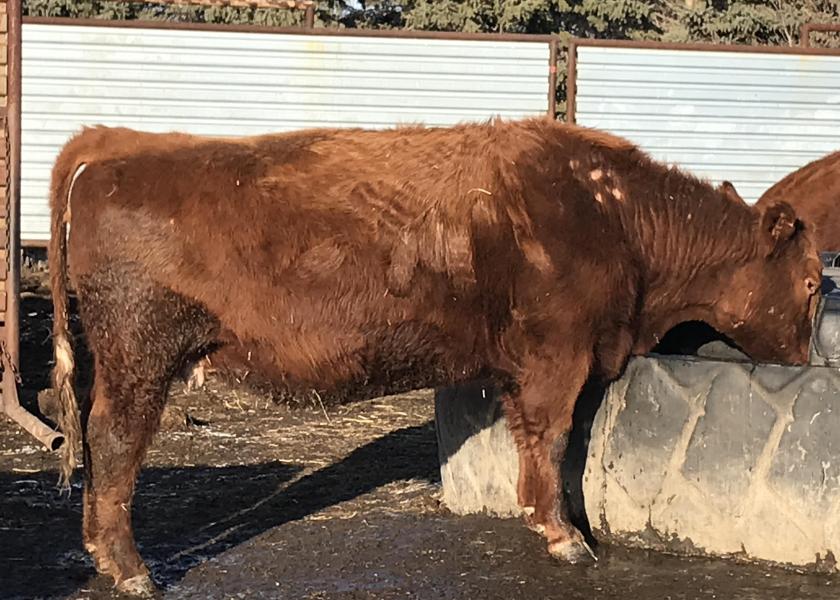Lice Infestations Rise With Mild Winter

In the midst of one of the mildest winters in North Dakota history, many ranchers are faced with lice infestations in herds even though they have treated their cattle.
Some even have treated more than once and still are seeing the effects of lice in their livestock.
“We are experiencing lice populations that are apparently much more difficult to control than previously,” says Gerald Stokka, North Dakota State University Extension veterinarian. “We cannot be sure as to the reason for reduced lice control, but the possibility of resistance to our control products is certainly on the minds of our veterinary practitioners.”
Lice Species Common in U.S.
Five species of lice commonly are found in the U.S., with certain regions of the country seeing variation in the species present. The common species are categorized as sucking (pierce skin and suck blood) or biting (feed on skin debris).
Sucking lice include the short-nosed cattle louse, long-nosed cattle louse and little blue louse. The most common biting louse is the red louse, also known as the cattle-chewing louse.
Lice infestations increase during cold weather and subside during warm weather in response to the increased surface temperature of their host. Although most cattle become louse free in the summer months, carrier animals (about 1% to 2%) remain infected and serve as a source of reinfestation during fall and winter months.
Lice essentially spend their entire life on the animal and cannot survive off the host for more than a few days, according to Stokka. The life cycle of lice on cattle varies from three to six weeks.
Transmission generally requires animal-to-animal contact. However, lice have been shown to grasp the legs of horn flies or houseflies and take a trip to another animal.
Diagnosing a Lice Infestation
Determining a lice infestation in cattle is generally an easy diagnosis for veterinarians and many producers. One indication of a lice problem is cattle that appear to have itchy skin.
Another sign is characteristic hair loss patterns in the neck, across the shoulders and withers, and in the udder area. Some hair loss may be significant enough to result in frostbite to hairless areas, especially in extended cold winter weather.
However, light infestations are easy to overlook when examining animals individually unless the veterinarian or producer does a careful inspection. A detailed exam starts with looking for nits, then exploring for lice by carefully parting the hair.
“A systematic and defined approach to the examination of cattle for the presence of lice will enable the examiner to have a higher level of confidence in attaining accurate results,” Stokka says.
Lice Control
The pioneer avermectin (macrocyclic lactone) products such as Ivermectin and Dectomax have been used extensively to control lice because of their effectiveness. With the development of the systemic “pour on” products, along with generic products, the use increased and, in some cases, these products have been used multiple times per year.
These products are absorbed through the hair follicles, so dirt and other foreign material on the backs of cattle will limit absorption. Other control products are strictly topical with no absorption.
“So whether we are dealing with resistance in lice or less efficacy at the appropriate dose, the result is the same - a lack of adequate control,” Stokka says.
Here are a few options to help curb lice outbreaks:
• Leave the lice alone. At this time of the year, colder weather will be an issue, thus treatment will be necessary. However, in March and April, the best solution may be to let the cattle itch for a while. Lice populations will begin to decrease in activity rapidly as the weather warms.
• Treat only those animals showing clinical signs of itching and hair loss. Some animals may be more sensitive to the effects of lice infestations, while others can handle some lice with natural resistance. If the entire herd is showing hair loss consistent with a lice infestation, then herd treatment is necessary.
• Determine the type of lice causing the infestation and use the correct control methods for that type. For example, sucking lice feed on blood and serum from the animal. These lice are controlled more effectively with a systemic injectable product. In contrast, biting lice feed on the dander and scurf on the skin. They are controlled more effectively with a topical treatment.
• Use an injectable and topical treatment to control both types of lice. However, no licensed products are labeled to be used concurrently.
“When looking at topical treatments to treat biting lice, it maybe in your best interest to look for name-brand products, and to use one with a higher volume dosage,” Stokka says. “Biting lice will be controlled more effectively by the parasiticide if they come in contact with it. Thus, the higher-dosage products will give you more coverage on the animal and more area for the lice to come in contact with the product.”







